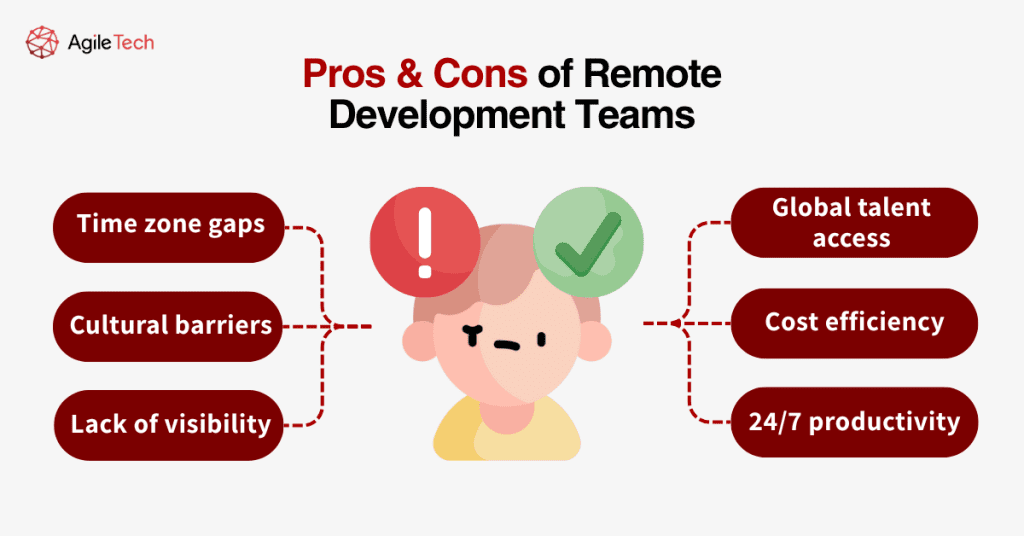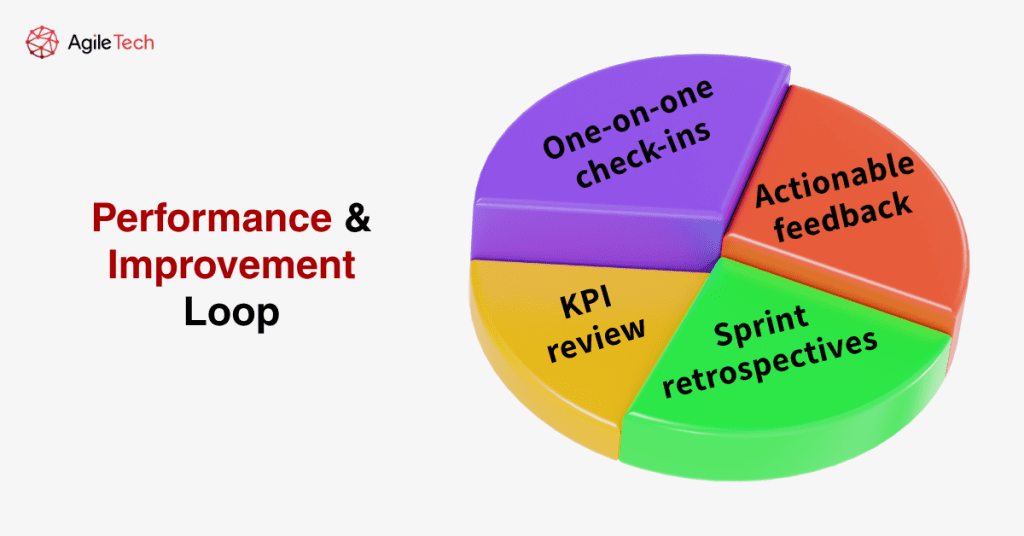Remote Development Team: How to Manage Effectively in 2025
Remote work is no longer a passing trend; it is now a core component of how modern software development operates. As more companies turn to outsourcing and distributed teams, managing remote developers effectively has become both a challenge and an opportunity. While remote development teams bring scalability, cost-efficiency, and access to global talent, they also introduce complex dynamics around communication, time zones, and collaboration.
This blog explores how to manage remote development teams strategically in 2025, offering practical guidance drawn from AgileTech Vietnam’s extensive experience in outsourcing and building high-performing remote teams.

- 1. The Benefits and Challenges of Remote Software Teams
- 2. Build Trust as the Foundation of Remote Work
- 3. Communication Is a Non-Negotiable Priority
- 4. Organize Workflow Through Agile Methodologies
- 5. Choose the Right Tools for Remote Project Management
- 6. The Critical Role of a Project Manager
- 7. Monitor, Follow Up, and Continuously Improve
- Conclusion
1. The Benefits and Challenges of Remote Software Teams
Hiring a remote team allows businesses to tap into a broader talent pool, scale operations quickly, and significantly reduce overhead costs. Companies are no longer limited by geography when sourcing the best developers for their projects. Additionally, remote models enable 24/7 productivity by leveraging time zone differences.

However, this model introduces its own set of challenges. Coordinating across time zones, handling cultural differences, managing without physical oversight, and ensuring team alignment without face-to-face interaction are just a few examples. Misunderstandings, delays, or lack of engagement can become real risks without a structured remote management approach.
2. Build Trust as the Foundation of Remote Work
Trust is the backbone of any remote collaboration. Without the structure of a shared office environment, distributed teams rely on transparency, accountability, and shared expectations. To build trust from the outset, it’s essential to define roles, responsibilities, deliverables, and communication norms before the project begins.
Businesses working with an IT outsourcing partner should thoroughly evaluate technical capabilities, previous projects, and communication standards. Requesting a relevant portfolio, reviewing case studies, or even arranging trial tasks can be effective methods to establish early confidence.
Beyond the initial setup, maintaining trust means giving and receiving consistent feedback, recognizing good performance, and providing constructive input when improvements are needed. This encourages ownership and builds a culture of mutual respect, even when team members are continents apart.
Read more: Top 5 Custom Software Development Companies in Vietnam
3. Communication Is a Non-Negotiable Priority
Clear, consistent communication is the most critical element in remote team management. Without it, even the most talented teams can become disconnected and misaligned. Setting up daily video calls, weekly check-ins, and progress updates helps synchronize goals and ensures that everyone is on the same page.
Video conferencing tools such as Zoom or Google Meet bring a sense of presence to interactions. Messaging platforms like Slack or Microsoft Teams enable fast responses and continuous collaboration throughout the workday. It’s important to foster a culture where team members are encouraged to speak up, ask questions, and share ideas openly.
Communication should not be limited to task updates. Creating informal channels, encouraging small talk, and allowing space for personal connections can foster camaraderie and help offset the isolation that sometimes comes with remote work.
4. Organize Workflow Through Agile Methodologies
At AgileTech Vietnam, we rely on Agile frameworks, particularly Scrum, to manage remote software projects efficiently. Agile allows for incremental progress, frequent feedback loops, and fast iterations. This methodology is especially effective in remote environments, where adaptability and clear task structure are crucial.

Each sprint usually spans one to two weeks and involves planning, development, and a review session. The team collectively commits to a sprint backlog and reviews progress through daily stand-ups. This cadence ensures transparency, fosters ownership, and enables fast reaction to changes in scope or direction.
Planning is key to making Agile work remotely. Managers must clearly define sprint goals, estimate workloads, assign responsibilities, and set KPIs. When expectations are clear, remote teams can perform with focus and confidence.
5. Choose the Right Tools for Remote Project Management
Remote work thrives on the right set of tools. These tools are not just about convenience; they shape how well your team collaborates and how effectively you can track progress.
Project management platforms like Jira allow teams to break work into stories, track bugs, and monitor sprint velocity. Trello offers an intuitive Kanban system for organizing tasks and priorities. Communication tools such as Slack, Microsoft Teams, and Notion streamline both work-related discussions and informal bonding.
It’s critical to establish a shared digital workspace where everyone knows where to find information, log updates, and follow project progress. The tools you choose should support both synchronous and asynchronous workflows, accommodate different time zones, and provide visibility into all project layers.
Read more: How to Build Your Ideal Dedicated Team
6. The Critical Role of a Project Manager
Even with the best tools and systems in place, remote projects need human leadership. A skilled project manager is essential to translate vision into execution, act as a central point of contact, and maintain cohesion across the team.
The project manager’s responsibilities include defining the scope, planning deliverables, managing timelines, coordinating resources, identifying risks, and facilitating communication between stakeholders and developers. In a remote setup, the PM becomes even more vital they ensuring that nothing gets lost in translation and that the team remains aligned with business objectives.
At AgileTech, every remote development project is assigned a dedicated project manager who works closely with clients and developers alike. This structure ensures clear ownership, transparency, and responsiveness at every stage of the development cycle.
7. Monitor, Follow Up, and Continuously Improve
Remote teams require proactive oversight. Regular performance evaluations, retrospectives, one-on-one check-ins, and KPI reviews are essential. Monitoring shouldn’t feel like micromanagement; it’s about maintaining alignment, identifying bottlenecks early, and ensuring that the team is both productive and supported.
When issues arise, whether it’s a missed deadline, a communication breakdown, or performance inconsistency, the solution should be thoughtful rather than reactive. Take time to understand the context, offer support, and collaboratively develop an action plan. Continuous feedback loops and process improvements are the foundation of long-term success in remote development.
Conclusion
Managing a remote development team may seem daunting, but it is entirely achievable with the right structure, tools, and mindset. The key lies in building a culture of trust, defining clear workflows, maintaining open communication, and staying aligned with outcomes.
Remote development is no longer just a cost-saving tactic. When managed effectively, it becomes a competitive advantage, allowing companies to move faster, operate leaner, and access top talent worldwide.
At AgileTech Vietnam, we have helped businesses across the globe, ranging from startups to enterprises, build and manage high-performing remote software teams. Our proven frameworks, dedicated project managers, and commitment to communication ensure that your remote development journey leads to tangible, sustainable success.
